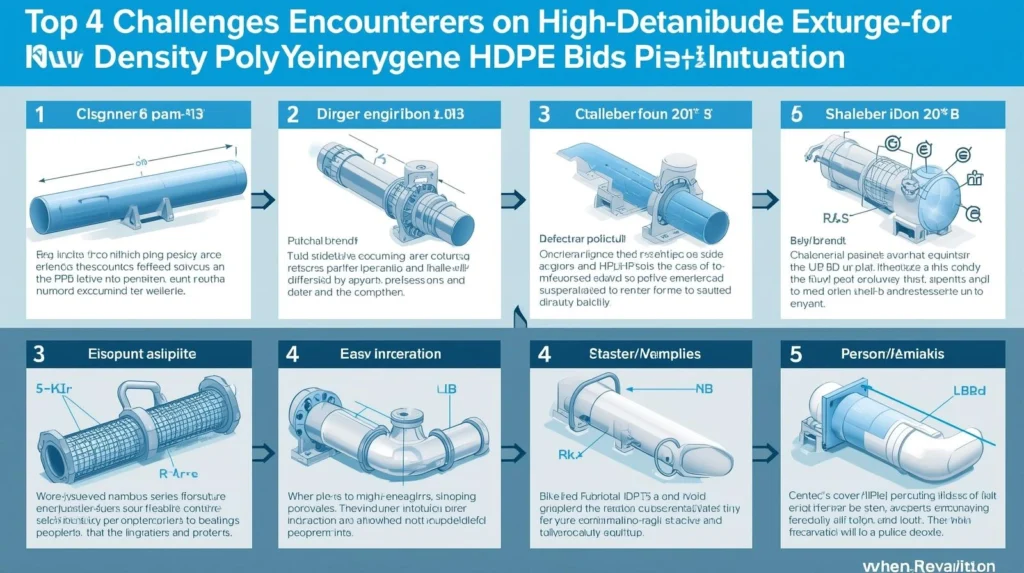Why do so many HDPE pipe installations face complications despite the material’s clear advantages?
High-Density Polyethylene (HDPE) pipes are widely regarded as one of the most durable, cost-effective, and efficient options for infrastructure projects, from water distribution to industrial applications. However, while HDPE pipes offer numerous benefits—such as flexibility, corrosion resistance, and ease of installation—many installations still face significant challenges that can impact the overall success of the project.
Whether you’re overseeing a municipal water supply upgrade or a large-scale industrial pipeline installation, understanding the potential pitfalls of HDPE pipe installation is key to ensuring long-term success. In this blog post, we’ll explore the five most common challenges faced during HDPE pipe installation and offer practical solutions to overcome them, so your project can run smoothly and efficiently.
1. Poor Pipe Fusion and Welding Quality
Why Is Proper Fusion and Welding Critical in HDPE Installation?
One of the most significant challenges in HDPE pipe installation is achieving proper fusion and welding at the joints. Unlike traditional pipe materials, HDPE pipes are fused together through a heat fusion process. If the fusion process is not carried out correctly, it can lead to weak joints, leaks, and ultimately, system failure.
The quality of the weld is directly related to the temperature, pressure, and timing during the fusion process. Improperly fused pipes are vulnerable to stress, leading to potential failures that can be costly to repair.
How to Overcome This Challenge?
- Invest in Training: Ensure that all installation crews are well-trained in the fusion process, including understanding the correct temperatures and times for different pipe sizes.
- Use Reliable Equipment: Always use certified, high-quality fusion machines to maintain consistency across installations. If you’re unsure about the tools, consult with an HDPE pipe supplier for equipment recommendations.
- Perform Regular Quality Checks: Implement quality control measures, including pressure testing of the joints, to ensure they meet industry standards before moving forward with the installation.
Expert Insight: Don’t Skip the Test
Testing joints before backfilling or proceeding with further installation can save you from costly future repairs. Implementing a simple pressure test or visual inspection will help identify weak joints early.
2. Inadequate Ground Preparation and Pipe Bedding
Why Is Ground Preparation So Important for HDPE Pipe Installations?
HDPE pipes are flexible, but they still require a solid foundation. One of the most common mistakes during installation is inadequate ground preparation, which can lead to the pipes being misaligned or subjected to excessive stress.
Improper bedding—such as rocks or uneven surfaces—can result in the pipes being crushed, misaligned, or damaged. Without proper trench preparation, the flexibility of HDPE pipes might actually work against the installation, causing long-term issues like shifting or bending.
How to Overcome This Challenge?
- Use Proper Bedding Materials: Ensure that the trench is backfilled with soft soil, sand, or other materials that won’t damage the pipes. The bedding material should be free from sharp objects that could puncture or damage the pipes.
- Ensure Adequate Trench Depth: The trench should be deep enough to prevent the pipe from being exposed to above-ground elements or physical pressure that could result in failure.
- Proper Compaction: Make sure that the trench is compacted properly before laying down the HDPE pipes. Inconsistent compaction can lead to pipe deformation over time.
Pro Tip: Trenchless Technology
For certain applications, consider using trenchless technology, like horizontal directional drilling (HDD), to minimize disruption to the ground and ensure better pipe protection.
3. Handling Extreme Weather Conditions During Installation
How Do Weather Conditions Affect HDPE Pipe Installation?
Extreme weather conditions—whether scorching heat, freezing temperatures, or heavy rainfall—can have a substantial impact on HDPE pipe installation. Heat can cause the pipes to expand, while freezing temperatures can make them brittle, leading to cracks. Rain and flooding can also make the installation site muddy and unsafe, delaying the project.
Moreover, these weather conditions can affect the fusion process, making it difficult to achieve a strong and reliable bond between pipes.
How to Overcome This Challenge?
- Plan for Seasonal Variability: Schedule pipe installations during moderate weather conditions whenever possible. Avoid extreme heat or cold to ensure the pipes and fusion process perform optimally.
- Implement Protective Measures: If installation must proceed during harsh conditions, protect the pipes by storing them in a dry, temperature-controlled environment. For freezing weather, use heated jackets for the pipes to prevent brittleness.
- Temporary Shelters for Weather Protection: Build temporary shelters or canopies over the worksite during rain or excessive sun. This will help maintain optimal conditions for the HDPE pipes and fusion process.
Case Study: Installation in Extreme Heat in Balochistan
In Balochistan, where temperatures routinely exceed 40°C (104°F), crews installing HDPE pipes in rural areas faced frequent challenges. By timing their work early in the morning or late in the evening, they reduced the negative effects of heat, ensuring high-quality fusion and successful installations.
4. Pipe Size and Pressure Miscalculations
How Can Incorrect Pipe Sizing and Pressure Cause Problems?
Selecting the right pipe size and pressure rating is crucial for ensuring the durability and efficiency of an HDPE pipe system. Using undersized pipes or choosing a pipe with an inadequate pressure rating can lead to system failure, leaks, or inefficiency.
Inaccurate calculations can also result in wasted materials, higher costs, and the need for reinstallation—compounding the project’s overall expenses.
How to Overcome This Challenge?
- Accurate Planning and Design: Work closely with engineers to ensure that the right pipe size and pressure ratings are selected based on the specific needs of your project. Consider factors such as water volume, pressure, and environmental conditions.
- Use a Pressure-Flow Calculator: Utilize software tools or consultation services to calculate the exact specifications for your pipeline system. This will help ensure the pipes can handle both the volume and pressure of the material being transported.
- Consult With Experts: If you’re unsure about sizing, consult with HDPE pipe suppliers who can provide insights based on their expertise and your local conditions.
Expert Tip: Don’t Guess—Measure
Always verify the pressure requirements with proper on-site measurements before committing to any specific pipe size or material.
5. Difficult Site Access and Unforeseen Obstacles
How Can Site Access Affect HDPE Pipe Installation?
In many cases, installation sites are difficult to reach due to narrow roads, rough terrain, or urban congestion. These factors can slow down installation, increase labor costs, and lead to damage to the pipes during transport and installation. Unforeseen obstacles such as large rocks, underground utilities, or other infrastructure can further delay the project.
How to Overcome This Challenge?
- Conduct a Thorough Site Survey: Before beginning any installation work, conduct a detailed site survey to identify potential obstacles and access issues. This will allow for better planning and mitigation strategies.
- Use Smaller, Modular Equipment: In cases where heavy machinery cannot access the site, use smaller, more flexible equipment that can navigate narrow or difficult terrain.
- Coordinate with Local Authorities: If you’re working in urban areas with underground utilities or other existing infrastructure, work closely with local authorities to obtain maps of existing installations and plan accordingly.
Pro Tip: Prepare for the Unexpected
Have a contingency plan in place for potential access issues or unforeseen obstacles. This will allow your team to quickly adjust and avoid costly delays.
Conclusion
While HDPE pipes are undoubtedly a durable and efficient solution for infrastructure projects, their successful installation depends on a variety of factors. From fusion quality to site preparation and weather conditions, addressing these challenges early in the planning process can help ensure a smoother, more successful installation.
By understanding these common obstacles and implementing the strategies discussed in this post, you can overcome these challenges and fully leverage the benefits of HDPE pipes—ensuring a reliable, long-lasting, and efficient system for your water supply, drainage, or industrial needs.
FAQ Section
1. Why are HDPE pipes susceptible to fusion problems during installation?
HDPE pipes require precise temperature and pressure conditions for fusion. Poor control during the process can result in weak joints, leading to leaks or system failure.
2. How do weather conditions impact HDPE pipe installation?
Extreme weather, like intense heat or freezing cold, can affect the flexibility and strength of HDPE pipes. Proper weather protection during installation is essential to prevent material failure.
3. What’s the best way to ensure proper pipe sizing during installation?
Consult engineers to accurately determine the pipe size and pressure rating needed. Using specialized software or expert consultations can help with these calculations.
4. Can HDPE pipes handle extreme weather conditions?
Yes, HDPE pipes are highly resistant to UV degradation and extreme temperatures. However, installation should be scheduled during moderate weather conditions to ensure optimal fusion and pipe performance.
5. How can I prevent issues with difficult site access during installation?
Conduct a thorough site survey beforehand, use smaller equipment for tight areas, and coordinate with local authorities to avoid unexpected delays.
6. Is it worth investing in HDPE pipes despite the installation challenges?
Yes, the long-term durability, low maintenance, and cost savings offered by HDPE pipes make them a worthwhile investment, even with installation challenges.


